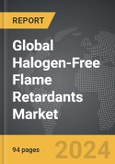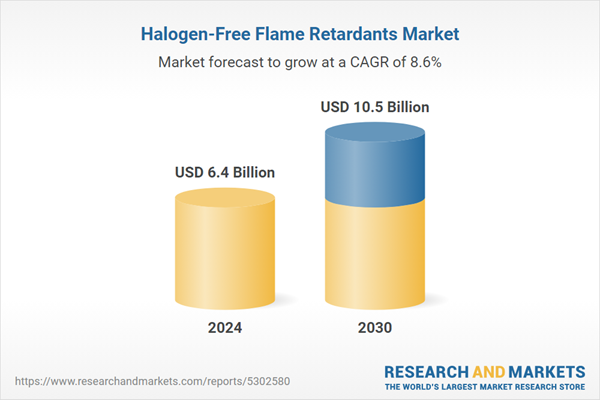The global market for Halogen-Free Flame Retardants was valued at US$6.4 Billion in 2024 and is projected to reach US$10.5 Billion by 2030, growing at a CAGR of 8.6% from 2024 to 2030. This comprehensive report provides an in-depth analysis of market trends, drivers, and forecasts, helping you make informed business decisions. The report includes the most recent global tariff developments and how they impact the Halogen-Free Flame Retardants market.
Segments: Type (Aluminum Hydroxide, Organophosphorous, Other Types); End-Use (Electrical & Electronics, Building & Construction, Transportation, Other End-Uses).
Geographic Regions/Countries: World; United States; Canada; Japan; China; Europe (France; Germany; Italy; United Kingdom; Spain; Russia; and Rest of Europe); Asia-Pacific (Australia; India; South Korea; and Rest of Asia-Pacific); Latin America (Argentina; Brazil; Mexico; and Rest of Latin America); Middle East (Iran; Israel; Saudi Arabia; United Arab Emirates; and Rest of Middle East); and Africa.
The analysts continuously track trade developments worldwide, drawing insights from leading global economists and over 200 industry and policy institutions, including think tanks, trade organizations, and national economic advisory bodies. This intelligence is integrated into forecasting models to provide timely, data-driven analysis of emerging risks and opportunities.
Global Halogen-Free Flame Retardants Market - Key Trends and Drivers Summarized
How Are Halogen-Free Flame Retardants Shaping Fire Safety Standards?
Halogen-free flame retardants are gaining widespread adoption as industries transition away from traditional halogenated flame retardants, which have been associated with environmental and health concerns. These flame retardants are designed to reduce the flammability of materials without releasing toxic gases when exposed to high temperatures. As fire safety regulations become more stringent across industries such as electronics, automotive, and construction, the demand for halogen-free alternatives is increasing. The use of halogen-free flame retardants in plastics, textiles, and building materials is seen as a critical step toward improving fire safety standards while reducing the environmental impact of chemical flame retardants.What Are the Key Segments of the Halogen-Free Flame Retardants Market?
Types of halogen-free flame retardants include aluminum hydroxide, magnesium hydroxide, and phosphorus-based compounds, each offering specific fire-resistant properties. These retardants are widely used in applications such as electrical and electronic components, building insulation materials, and automotive interiors. The electronics industry is one of the largest consumers of halogen-free flame retardants, driven by the need for fire-resistant plastics and components in devices and appliances. The construction sector also represents a significant market, as builders seek flame-resistant insulation and cladding materials that meet modern fire safety regulations. Geographically, Europe and North America are leading markets due to stringent fire safety regulations, while Asia-Pacific is experiencing strong growth due to rapid industrialization.How Are Technological Advancements Enhancing Halogen-Free Flame Retardants?
Technological innovations are playing a key role in improving the effectiveness and versatility of halogen-free flame retardants. New formulations are being developed to enhance the thermal stability, mechanical properties, and durability of flame-retardant materials. For instance, advancements in intumescent flame retardants, which swell and form a protective char layer when exposed to fire, are making them more effective in protecting plastics and textiles. Researchers are also exploring the use of nanotechnology to create flame retardants that offer enhanced performance with lower additive concentrations, reducing the impact on the physical properties of materials. These innovations are expanding the use of halogen-free flame retardants across a wide range of applications, from consumer electronics to building materials.What Factors Are Driving the Growth in the Halogen-Free Flame Retardants Market?
The growth in the halogen-free flame retardants market is driven by several factors, including increasing regulatory pressure to reduce the use of toxic and environmentally harmful chemicals in fire safety materials. As industries seek to comply with stringent fire safety standards, the demand for halogen-free alternatives is rising. The growing awareness of the environmental and health risks associated with halogenated flame retardants is also pushing manufacturers to adopt safer, non-toxic alternatives. Additionally, the expanding electronics industry, which requires fire-resistant materials to ensure product safety, is a major driver of market growth. Technological advancements that improve the performance and cost-effectiveness of halogen-free flame retardants are further fueling their adoption across industries.Report Scope
The report analyzes the Halogen-Free Flame Retardants market, presented in terms of units. The analysis covers the key segments and geographic regions outlined below.Segments: Type (Aluminum Hydroxide, Organophosphorous, Other Types); End-Use (Electrical & Electronics, Building & Construction, Transportation, Other End-Uses).
Geographic Regions/Countries: World; United States; Canada; Japan; China; Europe (France; Germany; Italy; United Kingdom; Spain; Russia; and Rest of Europe); Asia-Pacific (Australia; India; South Korea; and Rest of Asia-Pacific); Latin America (Argentina; Brazil; Mexico; and Rest of Latin America); Middle East (Iran; Israel; Saudi Arabia; United Arab Emirates; and Rest of Middle East); and Africa.
Key Insights:
- Market Growth: Understand the significant growth trajectory of the Aluminum Hydroxide segment, which is expected to reach US$4.4 Billion by 2030 with a CAGR of a 8.8%. The Organophosphorous segment is also set to grow at 9.2% CAGR over the analysis period.
- Regional Analysis: Gain insights into the U.S. market, valued at $1.6 Billion in 2024, and China, forecasted to grow at an impressive 12.4% CAGR to reach $2.6 Billion by 2030. Discover growth trends in other key regions, including Japan, Canada, Germany, and the Asia-Pacific.
Why You Should Buy This Report:
- Detailed Market Analysis: Access a thorough analysis of the Global Halogen-Free Flame Retardants Market, covering all major geographic regions and market segments.
- Competitive Insights: Get an overview of the competitive landscape, including the market presence of major players across different geographies.
- Future Trends and Drivers: Understand the key trends and drivers shaping the future of the Global Halogen-Free Flame Retardants Market.
- Actionable Insights: Benefit from actionable insights that can help you identify new revenue opportunities and make strategic business decisions.
Key Questions Answered:
- How is the Global Halogen-Free Flame Retardants Market expected to evolve by 2030?
- What are the main drivers and restraints affecting the market?
- Which market segments will grow the most over the forecast period?
- How will market shares for different regions and segments change by 2030?
- Who are the leading players in the market, and what are their prospects?
Report Features:
- Comprehensive Market Data: Independent analysis of annual sales and market forecasts in US$ Million from 2024 to 2030.
- In-Depth Regional Analysis: Detailed insights into key markets, including the U.S., China, Japan, Canada, Europe, Asia-Pacific, Latin America, Middle East, and Africa.
- Company Profiles: Coverage of players such as Adeka Corporation, Akzo Nobel, Albemarle Corporation, BASF SE, Celanese Corp and more.
- Complimentary Updates: Receive free report updates for one year to keep you informed of the latest market developments.
Some of the 43 companies featured in this Halogen-Free Flame Retardants market report include:
- Adeka Corporation
- Akzo Nobel
- Albemarle Corporation
- BASF SE
- Celanese Corp
- Chemtura Corporation Limited
- Clariant International Ltd.
- DKS Co., Ltd.
- Greenchemicals SpA
- Huber Engineered Materials
- Israel Chemicals Limited (ICL)
- Italmatch Chemicals
- J.M. Huber Corporation
- Kisuma Chemicals B.V.
- Lanxess AG
- Nabaltech AG
- RTP Company
Tariff Impact Analysis: Key Insights for 2025
Global tariff negotiations across 180+ countries are reshaping supply chains, costs, and competitiveness. This report reflects the latest developments as of April 2025 and incorporates forward-looking insights into the market outlook.The analysts continuously track trade developments worldwide, drawing insights from leading global economists and over 200 industry and policy institutions, including think tanks, trade organizations, and national economic advisory bodies. This intelligence is integrated into forecasting models to provide timely, data-driven analysis of emerging risks and opportunities.
What’s Included in This Edition:
- Tariff-adjusted market forecasts by region and segment
- Analysis of cost and supply chain implications by sourcing and trade exposure
- Strategic insights into geographic shifts
Buyers receive a free July 2025 update with:
- Finalized tariff impacts and new trade agreement effects
- Updated projections reflecting global sourcing and cost shifts
- Expanded country-specific coverage across the industry
Table of Contents
I. METHODOLOGYII. EXECUTIVE SUMMARY2. FOCUS ON SELECT PLAYERSIII. MARKET ANALYSISSOUTH KOREAREST OF ASIA-PACIFICARGENTINABRAZILMEXICOREST OF LATIN AMERICAIRANISRAELSAUDI ARABIAUNITED ARAB EMIRATESREST OF MIDDLE EASTIV. COMPETITION
1. MARKET OVERVIEW
3. MARKET TRENDS & DRIVERS
4. GLOBAL MARKET PERSPECTIVE
UNITED STATES
CANADA
JAPAN
CHINA
EUROPE
FRANCE
GERMANY
ITALY
UNITED KINGDOM
SPAIN
RUSSIA
REST OF EUROPE
ASIA-PACIFIC
AUSTRALIA
INDIA
LATIN AMERICA
MIDDLE EAST
AFRICA
Companies Mentioned (Partial List)
A selection of companies mentioned in this report includes, but is not limited to:
- Adeka Corporation
- Akzo Nobel
- Albemarle Corporation
- BASF SE
- Celanese Corp
- Chemtura Corporation Limited
- Clariant International Ltd.
- DKS Co., Ltd.
- Greenchemicals SpA
- Huber Engineered Materials
- Israel Chemicals Limited (ICL)
- Italmatch Chemicals
- J.M. Huber Corporation
- Kisuma Chemicals B.V.
- Lanxess AG
- Nabaltech AG
- RTP Company
Table Information
| Report Attribute | Details |
|---|---|
| No. of Pages | 94 |
| Published | April 2025 |
| Forecast Period | 2024 - 2030 |
| Estimated Market Value ( USD | $ 6.4 Billion |
| Forecasted Market Value ( USD | $ 10.5 Billion |
| Compound Annual Growth Rate | 8.6% |
| Regions Covered | Global |









